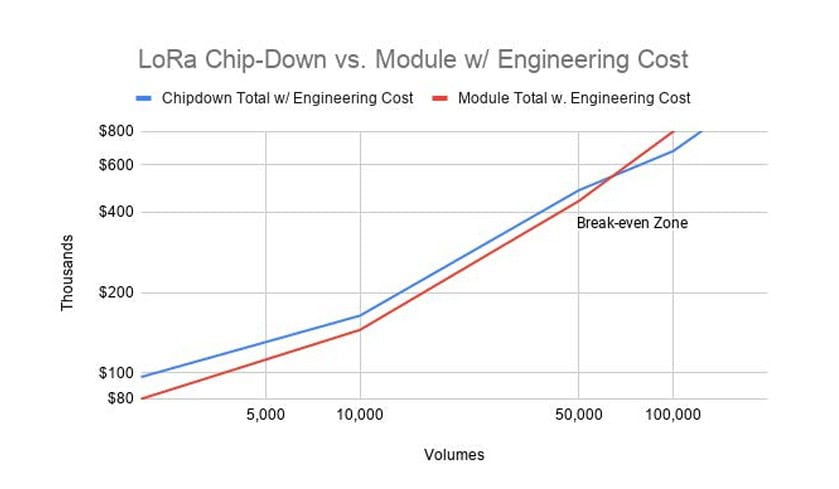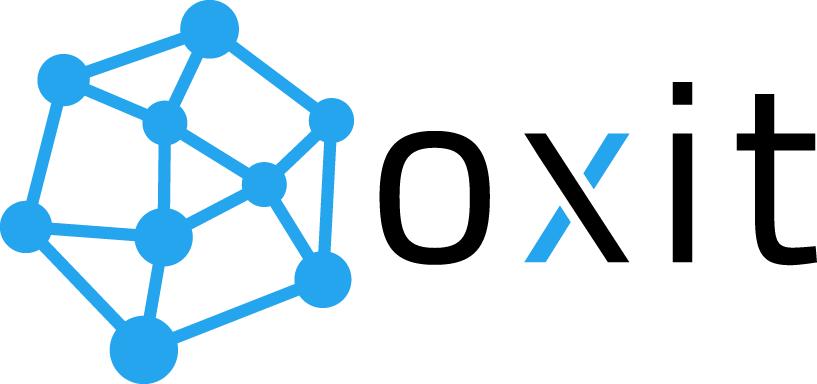Module or Chip-Down Design? A Cost Comparison and Breakeven Analysis
When adding LoRa functionality to your products, one of the critical decisions is whether to use a pre-certified module or go with a chip-down design. Both approaches have their advantages and difficulties, but the decision often boils down to two factors: cost and time to market.
In this article, we’ll compare the cost of using a commercially available pre-certified LoRa module versus designing your own chip-down solution. We’ll also examine where the breakeven point occurs, helping you make the most financially sound decision for your project.
The Basics: Pre-Certified Module vs. Chip-Down Design
Pre-Certified Module:
A pre-certified module is a commercially off-the-shelf component that simplifies integration into your product. It often includes a ready-to-use stack, SDK, and testing tools, allowing engineers to get started quickly. This speeds up development time and reduces product time to market but at a higher per-unit cost.
Chip-Down Design:
A chip-down design integrates LoRa functionality directly onto your circuit board. This approach provides identical(if done right) performance and reduces the bill of materials (BOM) cost compared to a module. However, it requires more specialized expertise in RF design, including layout, antenna design, and regulatory certifications.
Now, let’s compare these two options across key cost categories:

As the table shows, pre-certified modules are advantageous in areas like time to market and design effort, making them a great choice for companies looking for quick and simplified integration. Modules reduce complexity by handling most of the design work for you, particularly in terms of RF and antenna design, which minimizes the need for specialized resources and expertise.
On the other hand, chip-down designs come with a higher initial effort and resource cost. The need for extensive board design, lab equipment, and RF expertise increases both the complexity and risk. However, the payoff comes in the form of lower per-unit pricing, especially at higher production volumes, where chip-down designs become much more cost-effective, as seen in the $4.42 unit cost compared to $7.30 for the module at 100K volumes.
Both options often incur significant regulatory certification costs, as both must comply with regional standards like FCC and CE. LoRa modules are typically a bit different than other modules, as they generally do not have an antenna integrated into the module design. This means that if you use an antenna not included in the module’s FCC filing, then recertification is required. Additionally, if your design uses more than one radio (e.g., BLE), the FCC certification may become invalid if both radios operate at the same time. While WiFi and BLE modules often offer savings in certification, with LoRa and the need to optimize RF performance and cost, the compliance certifications may not provide the same benefits. Manufacturers must carefully consider the impact of regulatory requirements when choosing between module and chip-down designs.
The difference, however, lies in the development cycle—chip-down designs take more time and careful planning, which introduces moderate time-to-market risks compared to the faster-to-launch module option.
In summary, modules are ideal for speed and simplicity, while chip-down designs provide substantial long-term savings for larger production runs.
Key Assumptions:
- Pre-Certified Module Pricing: $7.30 flat between 10K-300K annual volumes.
- Chip-Down Design Pricing: $4.42 flat between 10K-300K annual volumes.
- Modules do not include antennas, so additional tuning and certification may be required for both options.
Time to Market: How Quickly Can You Launch?
Pre-Certified Modules shine in time to market. With a module, most of the design complexities have already been handled, and development teams can focus on integration and product design. This can shave months off the product development timeline, especially for smaller teams without extensive RF expertise.
Chip-Down Design, on the other hand, takes longer. You’ll need more time for layout, debugging, and antenna tuning. It also adds the risk of needing multiple iterations, especially when it comes to passing EMC and RF testing. However, once the design is complete, you benefit from significantly lower costs at higher volumes.
Breakeven Point: When Does Chip-Down Make Financial Sense?
While modules are convenient, there is a point where the higher unit cost of modules outweighs the benefits of rapid development. Based on cost analysis, the breakeven point typically falls between 50K and 100K units. After this volume, the lower unit cost of a chip-down design begins to justify the extra development effort.
This breakeven point can vary depending on factors such as:
- Product complexity: More complex products may benefit from the simplified integration offered by modules.
- Certification requirements: Both options require regulatory certifications, but chip-down designs can carry slightly higher risks and development cycles.
Below is a chart showing the cost per unit as volumes increase for both options:

What Could Go Wrong with a Chip-Down Design?
While the cost savings of chip-down designs are attractive, they come with their own set of risks:
- EMC/RF Testing: Passing regulatory certifications is often more challenging with a custom chip-down design compared to using a pre-certified module. Designing for optimal RF performance requires experience and careful attention to detail.
- Development Cycles: It’s not uncommon for chip-down designs to require multiple board spins before everything works perfectly. This can add time and cost if not properly managed.
However, these challenges are manageable with the right expertise. Partnering with an experienced team like Oxit can mitigate these risks and help ensure a successful product launch.
Conclusion: Making the Right Decision for Your LoRaWAN Product
Choosing between a pre-certified module and a chip-down design depends on your specific product needs, development resources, and volume expectations. For companies needing a fast time to market or without internal RF expertise, pre-certified modules are an attractive option. But for larger production volumes, chip-down designs offer significant cost savings.
At Oxit, we help companies make informed decisions about LoRaWAN product development. With our expertise in both Module and chip-down designs, we can help clients get to market with best-in-class products.
- Reduce costs by 60%
- Improve battery life by 25%
- Extend range by 30% (Fewer gateways needed)
Contact us today to learn how we can help you build the best LoRaWAN solution for your needs.



